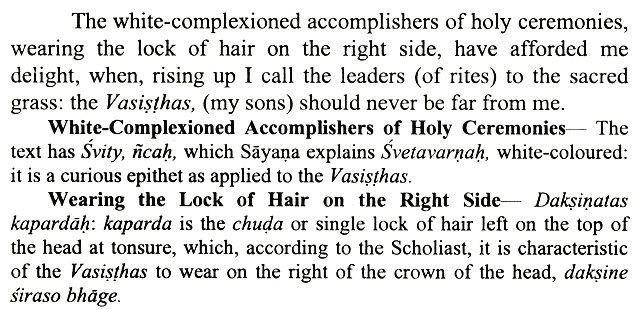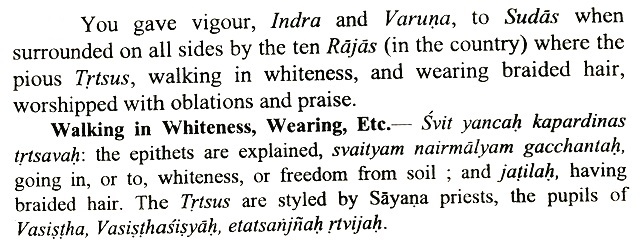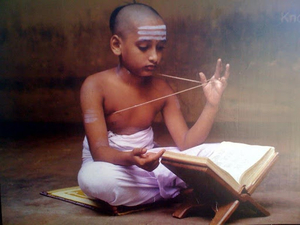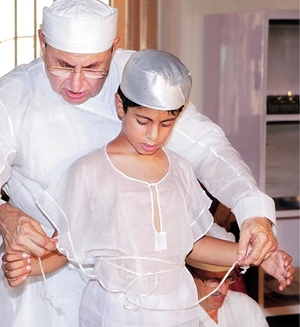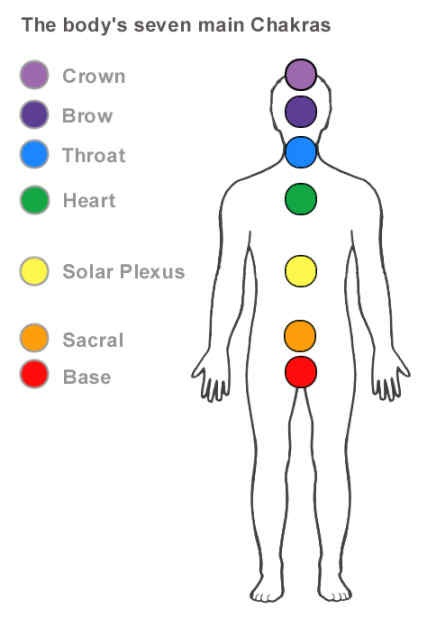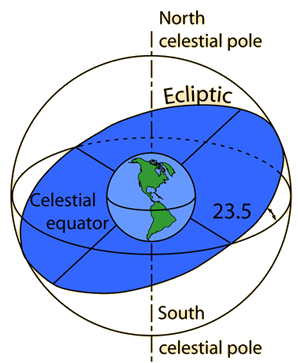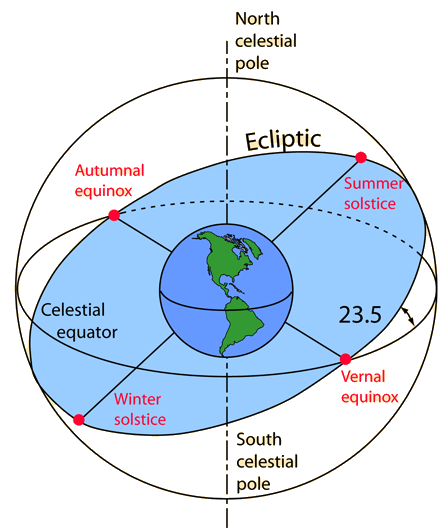
| ARYAN JANEU AND KUSHTI 1. History of Aryans :
We find many things common in Zoroastrians and Vedic Aryans which shows that somewhere the ancient roots are common.
For this we have to look into ancient scriptures. One of the oldest Aryan scripture is Rig Ved which was completed during 1500 and 1200 BC i.e. 3,520 to 3,220 years (calculated from July 2021).
Rig Ved Mandala 7, Sukt 33, Mantra (Hymn) 5426 by Vashishth - Mitravarun :
Translation
Explanation :
Some
translators have used word white robed is used instead of white-complexioned.
Their interpretation is as follows :
Translation
Explanation :
O
Indra-Varuna, ye gave Sudas your aid when the Ten Kings in battle
compassed him about,
This proves that since Vashishth who was a Vedic Aryan Priest of Trtsus tribe which was a Sub Clain of Bharats he, his descendants and Vedic Aryan priests used to wear white-Robes.
To know more about hairlock and white-robes Click here.
Rig Ved Dasharajnya or ‘Battle of ten Kings :
Later, Mandala VII records the full migration story of the Bharats and their priest Vashishth who came from across the Sindhu, ie. from eastern Iran (7.33.3).
As Witzel describes it : The geography of the battle hymn (and later summaries as in 7.33) clearly reflects a look back at the immigration of the Bharats. The process began behind the Sindhu, which Vashishth crosses in 7,33.9.* Then came the battle of the ten kings on the Parusni (the modern Ravi in Pakistan), near Manusa, a location in the back (west) of Kurukshetra. Their eventual arrival on the Yamuna and the defeat of the local chief Bheda are finally chronicled in 7.18.19. The whole process refers to the origins of the Bharats and Vashishth in eastern Iran; their move into the Subcontinent is also reflected elsewhere in book 7 (7.5.3, 6) and summed up in 7.33.3: thus he (Indra) transgressed with them (the Bharat) the Sindhu, thus he soon killed Bheda in (the Yamuna battle), thus, he helped Sudas in the Ten Kings Battle. Although they reached as far east as the Yamuna, however, their epi-centre was in the area around the Sarasvati, previously occupied by the now defeated Puru.
Zoroaster, Artharvan and Vashishth :
Yasna 9 and 17 cite the Ditya River in Airyanem Vaejah (Middle Persian Eran Wej) as Zoroaster's home and the scene of his first appearance. The Avesta (both Old and Younger portions) does not mention the Achaemenids or of any West Iranian tribes such as the Medes, Persians, or even Parthians. However, the Atharvan Clan, to which Zoroaster belonged, is mentioned, along with other Vedic persons, such as Vashishth and Yam (Yima), the ancestors of Sage Atharvan.
It is said that Zarathustra belong to the lineage of Vashishth to know more about it Click here.
Conclusion :
Location of descendants of Angiras and of Vashishth was in Iran especially eastern Iran of Vashishth.
Since the Vedic Aryan Priests wore white robes and Zoroaster belonged to Atharvan caste whose ancestors were Yam and Vashishth, wearing white robes in also found in Zoroastrianism.
Sage Atharvan along with Angiras composed Atharv Ved in which Janeu / Kushti is mentioned. This is how Janeu and Kushti came into Vedic Aryans and Zoroastrians.
When we further search for ancestors of Zoroastrians and Vedic Aryans we get the name Angiras / Ali.
To know more about Angiras / Ali Click here.
2. Introduction of Janeu and Kushti :
The sacred Yajñopavitam is known by many names (varying by region and community), such as Bratbandh, Janivaar, Jaanva, Jandhyam, Poita, Punul, Janeu, Lagun, Yajnopavit, Yagyopavit, Yonya and Zunnar. The other Sanskrit term for it is Avyanga.
Janeu is a scared thread which is worn by Aryan Brahmins and Kshatriyas on their shoulder. Zoroastrians wear Kusti / Kushti / Zonar around their waist. In Aryan Brahmins and Kshatriyas Yagnopavit ceremony and in Zoroastrians Navjote ceremony a person is considered as twice born.
Janeu
Kushti 3. Kushti :
It is said that kusti, represents the 72 chapters of one of the holy Zoroastrian books. It is woven of lamb’s wool and has tassels on both ends. It is wound around the waist three times to represent the good thoughts, good words and good deeds to be performed by the wearer. It is placed around the waist after the sudreh is put on. It is knotted twice, once in the front and once at the back. This sets a binding commitment to the Zoroastrian creed.
Bhramins, Kshatriyas and Zoroastrians are Aryans. Here, we have to go in history of when and how wearing sacred thread known as Janeu, Kushti / Zonar started in Aryans. We get a glimpse of this in Atharv Ved. Atharv Ved is composed by many Sages including Atharv / Atharvan.
Atharv / Atharvan Refrences :
India (Bharat) - Iran (Persia) and Aryans Part - 1
Angiras, Atharvan and Anu in Rig Ved
Pre-Zoroastrian Aryan Religions
Varun, Ved and Zoroastrianis : Chapter 2
Varun, Ved and Zoroastrianis : Chapter 3
Varun, Ved and Zoroastrianis : Chapter 7
There are total 4 Veds :
Above dates are related to completion of Veds.
Avestan was completed between 1500-1000 BCE (The Avesta is the scripture of Zoroastrianism which developed from an oral tradition founded by the prophet Zoroaster (Zarathustra, Zartosht)).
Being an Aryan Brahmin I dont know much about Zoroastrianism and its scriptures hence, I am quoting Vedic Hymns.
Though there are many other Aryan scriptures mentioning Janeu here I am giving example of Atharv Ved because all other scriptures came after Veds.
4. Atharv Ved :
In Atharv Ved Sukt 28 known as Dirghayu (Long life) / A charm to ensure general protection and prosperity written by Sage Atharv / Atharvan we get a glimpse of Janeu, Kushti / Zonar.
According to Atharv Ved Sukt 28 for a lenghty life till 100 years equalized with 9 aspirations where 3 are in Gold, 3 in Silver and 3 in Iron.
Fire (Agni), Sun, Moon, Earth, Water, Sky, Air, the quaters and points between them and parts of years accordant with seasons by 3 threaded amulet preserve the wearer. In three-threaded Charm rest triple fulness and Pushan covers it with milk and butter.
This charm is enriched by Adityas and magnified by fire (Agni). With strength of Indra there is triple power in it.
The 3 threads of amulets are Gold, Silver and Iron. By Gold protects Earth, with Iron protects Fire (Agni) and with Silver protects Plants.
This 3 fold is born of Gold which fire (Agni) is most dearly. When it fell one part injured Som and one part they called seed of sapient water.
The Gold brings wearer long life when triple threaded.
It contains 3 lives of Jamadagni, 3 vital force of Kashyap, 3 sites of Immortality and these 3 lives are prepared for wearer (3 + 3 + 3 = 9). With 3 string charm came 3 Eagles (in Sumerian Aryans Eagle also represents Sun) sharing sacred syllable and mighty. With immortality they drove off death, obscuring and concealing distress.
Endowed with strength person becomes master of foes.
The God who first bound on in the begining the deities immortal golden castle the 3 stringed charm is bind upon thee.
Aryaman, Pushan and Brihaspati are binder of 3 stringed charm.
To read Atharv Ved Sukt 28 Click here.
Thus, from the above Atharv Ved Sukt 28 translation we come to know that Janeu and Kushti is a charm meant for protection and prosperity.
In India a Bachelor Aryan Brahmin and Kshatriya wears 3 strands Janeu which was made of Gold, Silver and Iron. Earth protects a person through Gold, Fire protects a person through Iron and Plants protects a person through Silver.
Also, with Gold a person is guards from Sky, Silver guards a person from Air and Iron guards a person from Earth (earth has magnetic field which effects human body).
After marriage 6 strands and the 9 strands (nine aspirations) are also worn to signify the last 3 strands as a substitute for the Angvastra. Comparing with the Atharv Ved mantras we can understand the total of 3, 6 and 9 strands Janeu.
In Veds come important numbers like 3, 6, 7, 9, etc. are given which further needs to be studied.
5. Time Period :
Atharv Ved was written between 1000-900 BCE
Avestan was written between 1500-1000 BCE
This is the time period when all Aryans stayed together. The Sumerians are Aryans but in Sumerian statues we dont see Janeu or Kushti is because this concept came during 1000-900 BCE i.e. from July 2021 total years are 3,020 years and 6 months to 2,920 years and 6 months.
Zoroastrianism
:
The Kushti is made of 72 fine, white and woolen threads here again the question comes in our mind why 72?.
It takes about 72 years for the Earth’s axis to rotate through one degree – so it takes nearly 26,000 years to make one 360-degree circular turn.
In India Nowruz is celebrated by the name Holika Dahan. In Zoroastrians Nowruz begins at the spring equinox (vernal equinox), when the sun crosses the equator and day and night are equal length. It is said that Nowruz is celebrated for more than 3,000 years. This is the same time period of Atharv Ved i.e. 1000-900 BCE i.e. from July 2021 total years are 3,020 years and 6 months to 2,920 years and 6 months.
Rig ved was written during 1500 and 1200 BC i.e. 3,520 to 3,220 years (calculated from July 2021) thus, the ancient Aryans knew calculation of Vernal Equinox.
Equinox is mentioned in Rig Ved having 72 years. The Wheel of Time with 12 spokes to define 12 zodiac signs is mentioned as having 360 sub-spokes for measuring each day of the year and each degree of movement of Vernal Equinox in every 72 years.
To know more about Vernal Equinox as mentioned in Rig Ved Click here.
6. Reasons for wearing different style of Janeu and Kushti :
There are 4 possibilities :
1) War of 10 Kings :
In the War of 10 kings Sudas defeated 10 Kings and casted them out. In ancient times a lot of battles and wars took place and there was a mixture of various tribes both Aryans and Non-Aryans. To differentiate between Aryans and Non-Aryans the concept of Janeu / Kushti was formed in Aryans but since the Iranian Aryans were not in good terms with Vedic Aryan tribes because they sided against Vedic Aryan King Sudas in Dasharajnya or 'Battle of Ten Kings' also known as Battle of 10 kings they wore Janeu around waist and the Vedic Aryan Yagna became Zoroastrian Yasna.
2) Zoroaster :
It
is said that Zarathustra belong to the lineage of Vashishth hence
it is possible that zoroastrians and Vedic aryans share same concepts.
Sage Atharvan along with Angiras composed Atharv Ved.
Zoroastrianism, was founded by the prophetic reformer Zoroaster in the 6th or 7th century BCE this is the same time in India when different religions like Buddhism and Jainism were formed.
Many scriptures and epics such as Ramanayan were written during this time period. Hence, it is possible that the base of Sumerian Aryan civilization and Vedas remained same but with variations in method and teachings.
To know more about difference between Aryans and Hinduism Click here.
3)
Vedic Aryans and Vernal Equinox :
When a person is standing straight on ground he forms a 90° angle and Janeu is a representation of Epletic Plain. The left shoulder represents Summer Solstice and the right thigh represents Winter Solstice.
When a person wears Janeu in cross from shoulder to thigh the center of the Janeu becomes Vernal Equinox. In human body the center of Janeu is Solar Plexus.
Solar Plexus Solar Plexus / Manipur Chakra :
Spiritually Solar Plexus is called Power House of our body. Whatever we eat or drink digests here. Pran Shakti is diverted from it and circulates to each and every vein, organ, spinal cord and brain and in turn gives energy to our body.
Holi :
In India Vernal Equinox is celebrated as Holi the arrival of spring, the end of winter. The festival also celebrates the beginning of a good spring harvest season. It lasts for a night and a day, starting on the evening of the Purnima (Full Moon Day) falling in the Hindu calendar month of Phalgun, which falls around the middle of March in the Gregorian calendar. The first evening is known as Holika Dahan (burning of Demon Holika) or Chhoti Holi and the following day as Holi, Rangwali Holi, Dol Purnima, Dhuleti, Dhulandi, Ukuli, Manjal Kuli, Yaosang, Shigmo or Phagwah, Jajiri.
Holi celebrations start on the night before Holi with a Holika Dahan where people gather, perform religious rituals in front of the bonfire, and pray that their internal evil be destroyed the way Holika, the sister of the demon king Hiranyakashipu, was killed in the fire. The next morning is celebrated as Rangwali Holi (Dhuleti) – a free-for-all festival of colours, where people smear each other with colours and drench each other. Water guns and water-filled balloons are also used to play and colour each other. Anyone and everyone is fair game, friend or stranger, rich or poor, man or woman, children, and elders.
Astronomy :
Ecliptic Plane :
If the sun's path is observed from the Earth's reference frame, it appears to move around the Earth in a path which is tilted with respect to the spin axis at 23.5°. This path is called the ecliptic. It tells us that the Earth's spin axis is tilted with respect to the plane of the Earth's solar orbit by 23.5°. Observations show that the other planets, with the exception of Pluto, also orbit the sun in essentially the same plane. The ecliptic plane then contains most of the objects which are orbiting the sun. This suggests that the formation process of the solar system resulted in a disk of material out of which formed the sun and the planets. The 23.5° tilt of the Earth's spin axis gives the seasonal variations in the amount of sunlight received at the surface.
Ecliptic The
Ecliptic :
Equinoxes
and Solstices :
Equinoxes and Solstices
Solstice 4) Zoroastrianism and Vernal Equinox :
When a person is standing straight on ground he forms a 90° angle the waist becomes the center part of the body and it is possible that Zoroastrians consider waist as Vernal Equinox.
Sacral / Swadhisthan Chakra :
Swadhisthan, is also known as the creativity and sexual chakra. It is located above the pubic bone and below the navel, and encompasses the genital region and the hypogastric plexus. The word Swadhisthan can be translated as “the dwelling place of the self,” and the element of the second chakra is water, which equals cohesiveness. A balanced second chakra leads to feelings of wellness, abundance, pleasure, and joy.
Nowruz :
Nowruz
is the Persian New Year. It is also known as Nauryz, Navruz or Nowrouz,
it means "new day." The new year will ring in on Saturday,
March 20.
It's no coincidence it falls on the first day of spring. The Iranian calendar is a solar calendar, meaning time is determined, through astronomical observations, by Earth's movement around the Sun. So, the first day of the year always kicks off with the natural phenomenon of the vernal equinox.
Traditionally celebrated on the vernal equinox, many begin preparations for Nowruz weeks in advance. The spring festival’s focus is fertility and new life, so it’s appropriate that many revelers celebrate with seeds and eggs.
Here we can find similarity between Holi and Nowruz and its connection with Vernal Equinox.
7. Age of wearing Janeu and Kushti :
In Atharv Ved there is no mention of age limit for wearing Janeu infact it does not even mention if a Janeu should be on shoulder or waist.
A Janeu is a protection Amulet and it is possible that in ancient times when a child went to Gurukul for education he wrote Janeu made of Gold, Silver and Iron for protection against evil forces in jungle.
Zoroastrians :
A child, of Zoroastrian parentage is initiated into the faith after he or she completes six years of age. Some perform the initiation ceremony at the age of 9 years, and in the case of boys, in exceptional circumstances the ceremony can be performed even at the age of eleven. In Iran the traditional age for initiation was 15 years. The child should be at an age where he or she understands the importance of the ceremony and can learn the prayers by heart. However, it is incumbent that the ceremony is done before the child reaches puberty.
This
very important Zoroastrian ceremony of initiation is called the
Navjote (Nav= new; jote= initiate), when the new initiate is taken
into the faith through the investiture of the sacred sudreh and
kushti.
The sacred thread (yagnyopavit or janeu) is received by the boy during this ceremony, that he continues wearing from left shoulder to the right crossing the chest thereafter. Generally this ceremony should be done before the age of 16.
According to Manu Smriti the age of wearing Janeu for Bhramins is 8 years and for Kshatriyas it is 11 years.
To know about different scriptures mentioning age for Janeu Click here.
Conclusion :
There is a ceremony for wearing Janeu but the purpose behind wearing Janeu is clearly given in Atharv Ved as stated above and hence I am not writing about the ceremony as the main purpose is more important.
Moreover, whenever there is a conflict between Veds and other scriptures only Veds are considered as authentic because they are the oldest and most authentic source rest all were written after a long time period by Aryans as well as Non-Aryans and hence there can be corruption and errors. |
|||||||||||||||||

